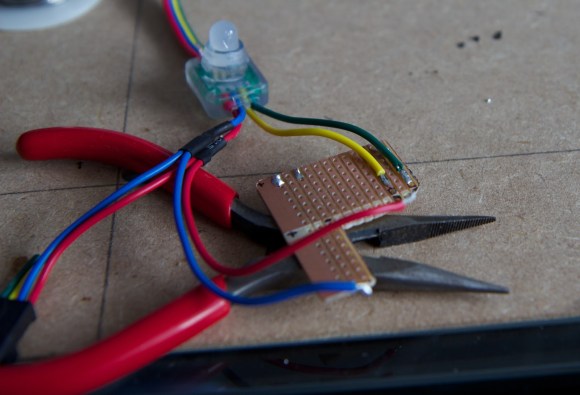
After reading about an initiative between NASA and Boeing to develop lights for the International Space Station [Rasathus] decided to give it a go at building his own. The project uses RGB pixels to build a circadian rhythm light installation. Without the normal rise and fall of the sun the sleep wake schedule for the astronauts can be pretty rough. This uses color and intensity of light in a well-defined schedule to help alleviate that. [Rasathus] is trying to bring his project in well under the $11.1 million mark which was established for the ISS.
The light modules he’s using are from a strand of LEDs from Adafruit. Each is driven by a WS2801 controller, a common driver used for easy and complicated projects like this huge ball of light which our own [Jesse Congdon] tackled. The board above is the start of an adapter board for interfacing with the Raspberry Pi GPIO header. [Rasathus] wanted to make certain he didn’t fry the control electronics so he built some protection into this adapter. The control software is covered in the second portion of the write up. We’ve embedded the video from that post after the break.














Very cool!
I’m really struggling to understand the cost of NASA’s expected $11.1 million. Just another example of how everything seems to cost a ridiculous amount of money for something that could also be achieved by someone in their shed/garage/bedroom/kitchen table etc for not even a slight fraction of the price of $11.1 million.
I believe for health and welfare systems, they require that electronics be hardened and excessively redundant. The older Mars rovers wouldn’t have lasted so much beyond their expected lifetime if it wasn’t for quality control that seems, to Earthling standards, excessive. Sure, the lighting isn’t going to make or break a mission, but it does affect the performance of the crew on a daily basis – which eventually could make or break the mission.
The engineering that went into figuring out the right way to present the colors is the important part, remember NASA rarely buys off the shelf tech. Also again QC, it is expensive to ship spares or replacement parts later so they would rather take the time down here to make sure it is perfect.
It would be more like $1 million for R&D and $100k for implementation.
All Electronics on board are designed to tolerate some pretty harsh conditions, along with redundancy. Also don’t forget, it has to work the first time around, once it goes up there replacing it is not a simple task.
Because simulating daylight is not actually as simple as slapping a few RGB leds on a board and calling it done.
First of all you need to research and study which wavelenghts do what at what times, and how much do you need, and how much is healthy, and what kind of emitters you need to make those wavelenghts.
A simple random off-the-shelf RGB LED probably won’t even have the right wavelenght of blue to affect melatonin production.
The first few post here perhaps go someway to explaining why anyone who ever took basic electronics scratches their head at the 1.1 mill price tag.
http://www.raspberrypi.org/phpBB3/viewtopic.php?t=32154&p=277502
The main controller (raspberry pi) won’t last in space his led driver isn’t tested for space nor is the led.
So this thing will work just fine on the ground! But it probably cost about 1.5 billion dollars testing and certifying this thing for space.
How would this not last in space exactly?
There’s nothing in the system that would be affected by a microgravity environment on board the ISS is there?
If anything, the Pi (and the rest of the chips) isn’t radiation hardened. Due to lack of atmosphere and the earths magnetic field and whatnot, ionizing radiation shoots through the ISS a lot more than here on Earth. Ionizing radiation can scramble bits in ICs that aren’t radiation hardened, possibly leading to catastrophic failure.
As I said, read the post linked to.
There are stresses at launch as well as radiation in space to consider.
the point isn’t that the raspberry pi isn’t able to be adapted for use in high radiation environments with decent shielding etc, just that it’s not quite the case that you can bolt together 3 bits from RS and pretend that you’ve got something ready for space.
My post was supposed to in response to the first post saying how does it cost so much to develop this. the simple answer is that it’s not that simple.
Yep, having worked in the space industry, I can tell you most of the costs go to testing.
Think about it, the ISS and other spacecraft have a limited oxygen supply. If the device can overheat and burn (outgassing toxic fumes) or actually catches fire – in your garage you can just wave your hand around and clear the odor and put out the fire and recirculate the air. In space you can’t ‘roll down the window’ and flames or outgassing can kill, either directly or by consuming limited resources. There is a lot of testing to make sure this doesn’t happen. For electronics on the space shuttle, for example, most electronics were tested so that each electrical input (including i/o lines, not just input power) could handle a simulated lightening strike, and still function normally.